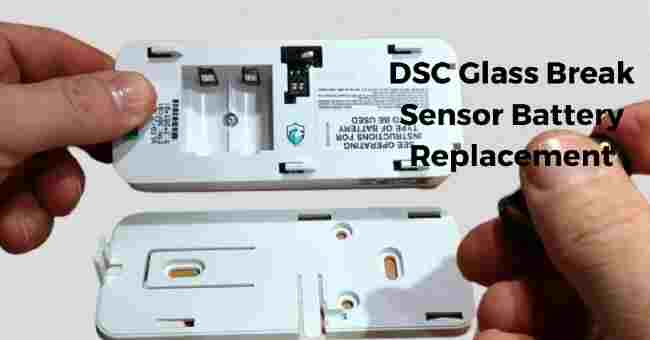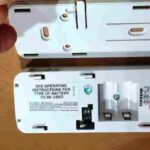If you have ever wanted to know how to replace dsc glass break sensor battery replacement? Yes, glass break sensors absolutely require batteries to function properly.
Without power, these important security devices are totally useless. I learned this the hard way after my home was broken into.
The sound of shattering glass downstairs woke me up that frightening night.
But my alarm never triggered because the glass break sensor batteries were dead. I had neglected to check them for too long.
After that experience, I vowed never to let my batteries run down again. Now I religiously replace them once a year.
In this article, I’ll explain exactly how to change glass break sensor batteries so you can avoid the terrifying situation I endured.
I want you to always stay protected. Let’s dive in.
How Do DSC Glass Break Sensors Work?
Before we jump into the battery replacement process, let’s take a quick look at how glass break sensors work so you understand why fresh batteries are important.
DSC glass break detectors use built-in microphones to listen for frequencies between 4-10 kHz.
This range covers the distinctive sound spectrum a window makes when shattered or broken.
When the sensor detects this audio pattern, it triggers a connected alarm control panel to sound the burglar alarm and send an alert.
This all happens very quickly, allowing the system to activate before an intruder even has time to climb through the broken window.
To keep their sensitive microphones turned on and listening 24/7, DSC glass break sensors require a constant source of power. They run on standard CR123 lithium batteries—two per sensor.
Over time, these batteries become depleted and must be replaced to keep the detectors running properly.
DSC recommends replacing the batteries every 1-2 years depending on your specific environment and activity.
Now let’s look at how to remove and swap the dead batteries for fresh ones.
Some Steps to Take on How To DSC Glass Break Sensor Battery Replacement
- Remove the Sensor from the Wall Mount
- Locating the Battery Compartment
- Removing the Old Batteries
- Inserting the New CR123 Batteries
- Reattaching the Sensor to the Wall Mount
- Avoiding False Alarms During Battery Changes
How to Remove the Sensor from the Wall Mount
DSC glass break detectors are mounted on wall plates secured to the ceiling or wall surface. To get to the batteries, you first need to detach the sensor from this mounting plate.
Here are the simple steps for safely removing a DSC glass break sensor from its wall mount:
1. Locate the Release Tab
Begin by locating the small plastic release tab on the back of the detector. This tab is on the outer edge and sticks out slightly from the rest of the case.
2. Press In the Release Tab
Use your finger to press the release tab inward towards the detector. You will both hear and feel an internal click when it engages.
3. Slide the Detector Sideways
With the tab pressed in, slide the entire glass break sensor unit sideways towards the large notch in the perimeter of the wall mount plate.
As you slide the detector, it will detach from the locking posts that hold it in place on the mount. Continue sliding until it is free from the mount.
4. Tilt the Sensor Unit Off the Mount Plate
Once fully shifted over, slowly tilt the glass break sensor unit downwards to disengage it from the wall mount plate entirely. Move carefully to avoid accidentally dropping it.
And with that, you now have the sensor separated from its mount and are ready to access the batteries.
Locating the Battery Compartment
With the sensor unit removed, turn it over to locate the battery compartment on the back side.
The battery compartment is a rectangular opening with two battery slots inside. It is centered on the back of the detector.
There are no screws or caps covering the battery compartment – it is designed for quick and easy access whenever the batteries need changing.
Inside the battery slots, you will see the tops of the two CR123 batteries used to power the sensor. Now let’s go over how to remove and replace them.
Removing the Old Batteries
To swap the depleted batteries for fresh ones, follow these simple steps:
1. Grip and Remove the First Battery
Pinch the first battery between your thumb and forefinger. Lift it straight out of the compartment slot.
2. Remove the Second Battery
Do the same for the second battery, pinching it between your fingers and lifting it straight upwards.
Try to avoid tilting the batteries, which could make them harder to extract. Lift them straight up and out.
And that’s it! With the two dead batteries removed, the compartment is now ready for the new replacements.
Inserting the New CR123 Batteries
DSC glass break sensors require two 3-volt CR123 lithium batteries. When installing the new batteries, follow these guidelines:
1. Check Battery Orientation
CR123 batteries are shaped with one rounded and one flat end. Examine the batteries first and note which end is rounded versus flat.
2. Insert with Rounded End Facing Out
Place the first battery into one slot with the ROUNDED end facing outwards. This aligns the positive and negative ends correctly.
3. Repeat for the Second Battery
Insert the second battery in the same orientation, with the rounded end facing out and the flat end inward.
4. Align Within the Slots
Gently slide each battery fully into its slot, ensuring it is straight and properly aligned within the compartment.
Correct battery orientation is critical for proper sensor operation and to avoid damage. Always take a moment to double check you are inserting CR123s in the right direction before closing up the detector.
Reattaching the Sensor to the Wall Mount
With fresh batteries installed, you can now reattach the glass break sensor onto its wall mount plate.
To re-mount the detector, follow these steps:
1. Connect the Guide Tabs on the Sensor
On the back of the sensor are two small plastic guide tabs protruding from the case. Orient these so they match up with the guide slots on the mount plate.
2. Slide the Sensor Onto the Mount
Maintaining this aligned position, slide the glass break sensor straight back onto the mount plate until it clicks securely into place.
3. Check Proper Mounting
Gently try to jiggle or slide the sensor to verify it has locked firmly onto the mount. It should not detach or move if properly reconnected.
And that’s all there is to it! With fresh batteries installed and the unit remounted, your DSC glass break sensor will be ready to continue protecting your home or business.
Avoiding False Alarms During Battery Changes
One important tip when replacing glass break sensor batteries is to take steps to avoid false alarms.
Since swapping the batteries requires detaching the sensor from its mount, the alarm system will temporarily lose connection to the device.
This could be falsely interpreted as a tampering or trouble condition.
To prevent false alarms or trouble signals:
- Notify your monitoring center – Let them know you will be changing the glass break sensor batteries so they can disregard any signals during this time.
- Put your system on test mode – This suspends alarm sounding and signal transmission. Just don’t forget to take the system off test mode when finished!
- Change one sensor at a time – Only remove one detector from its mount at a time to maintain protection on other areas.
Following these basic precautions will allow you to change batteries seamlessly without disruptions to your alarm system.
Regular Sensor Battery Changes Are Key for Security
Now you know just how quick and easy it is to swap out the batteries in DSC glass break sensors to keep them performing at their best.
With the detector’s sensitive microphone and alarm triggering circuitry powered by the two onboard batteries, having fresh ones is critical for reliable protection.
I recommend examining your glass break sensors at least annually to check the battery status. Fully depleted batteries can render the detectors unable to pick up glass break events.
Replacing the batteries every 1-2 years is a small investment to ensure your security system can continue detecting intruders and triggering alarms to keep your property secure.
Proper battery maintenance gives you peace of mind knowing your glass break sensors will be ready when needed most.
DSC sensors are just one component of a robust security setup.
Be sure to also follow manufacturer recommendations for other devices such as motion detectors, control panels, and wireless transmitters.
And don’t forget to test your complete system on a regular basis as well.
With high quality DSC security equipment and proper maintenance like routine battery changes, you can protect your home or business around the clock against the threat of break-ins and property crime.
If you found this tutorial helpful for replacing your DSC glass break sensor batteries, be sure to also check out my other articles and guides focusing on DIY home security installation, maintenance, and troubleshooting.
I aim to provide practical tips and expertise you can really use to reinforce your property’s defenses.
And if you have any other questions about DSC products or alarm systems in general, don’t hesitate to get in touch.
I’m always happy to help fellow DIY enthusiasts enhance their security knowledge and skill set. Here’s to staying safe and secure.
FAQs
Do Glass Break Sensors Need Batteries?
Glass break sensors absolutely require batteries to operate. The sensitive microphone and amplifier circuits in these devices need a power source to be able to detect the sound of shattering glass. Most glass break sensors use common lithium coin cell batteries like CR123A or CR2450.
These long-life batteries can power the sensors for up to 2 years before needing replacement. Without fresh batteries installed, a glass break detector will be rendered fully inoperable.
So regular battery checks and changes are essential for keeping these important security devices functioning properly.
Don’t let your glass break protection go dead – be sure to swap the batteries according to the manufacturer’s recommendations.
What Is The Life Of The Battery In The Glass Break Sensor?
Most quality glass break sensors will get 1-2 years of battery life before they require fresh cells. Factors like the number of alarm events, environmental conditions, and battery brand can impact lifespan.
Frequent glass break triggers will deplete batteries faster. Hot or cold temperature extremes can strain batteries over time as well.
Your specific environment and activity patterns will determine how long your glass break sensor batteries last.
But as a general rule, plan on annual battery checks at minimum. If your batteries are over a year old, replacement is a good idea for reliable protection.
The minor cost of new batteries every couple years is worth it for the peace of mind of knowing your sensors are alert and ready to detect any glass fractures.
How Do You Reset A Glass Break Sensor?
Resetting a glass break sensor is handled differently depending on the specific model and manufacturer.
But in most cases, resetting requires removing the unit from its mounting base for a period of time.
This essentially “re-learns” the sensor and clears any temporary faults or malfunctions that could be preventing proper operation.
To reset, simply unmount the sensor by disengaging it from its base plate or bracket. Leave it separated for 20-30 minutes so the internal detection circuits fully reset.
Then remount the glass break sensor securely onto its base once again. Run a few tests to confirm normal operation before considering the device fully reset.
If issues persist, a hardware problem may exist requiring service from the security provider. But a basic reset procedure should restore most intermittent glitches.
How Do You Activate A Glass Break Sensor?
Glass break detectors do not have an activation switch or button – they operate continuously to protect against glass fractures 24/7.
But false alarm testing can be done to verify they will detect and trigger upon glass breakage when needed.
The best way to safely simulate glass shatter is by using the sensor’s own test mode function.
Most have a feature that will put them into a temporary state allowing certain loud sounds to activate an alarm signal.
Enable test mode per the manufacturer’s instructions, then create a sharp, abrupt loud sound near the sensor by snapping your fingers, clapping hands forcefully, or tapping a hard object.
The sensor should detect this noise while in test mode and send an alarm signal showing it’s working properly.
Just be sure to take it out of test mode when finished to return to normal security monitoring.
Why Is My Glass Break Sensor Not Working?
If your glass break sensor fails to trigger during testing, there are a few common issues that could explain why it’s not working properly:
- Dead or missing batteries – No power means no operation, so dead batteries are the #1 cause of failure.
- Faulty wiring connections – Check that wiring connections to the alarm panel are intact.
- Sensitivity set too low – Some models allow adjusting the audio sensitivity level, make sure it is set high enough.
- Interference from other devices – Nearby electronics or appliances emitting certain radio frequencies can interfere with glass break microphones.
- Physical damage – Severe impacts can damage the microphone and circuitry, rendering the sensor unable to detect glass shatter events.
- Exceeded service life – Sensors can degrade over 5-10 years of use. If your unit is outdated, replacement may be the solution.
If batteries are new and connections are okay, contact your security provider for assistance in determining the exact cause of the issue.
How Do I Know If My Glass Break Sensor Is Working?
Regular testing is the only way to verify your glass break detector remains fully functional. Sensor self-tests should be performed at least every 3-6 months.
Put the system into test mode, then create a sharp abrupt sound like a hand clap. Confirm the sensor transmits an alarm signal as expected.
You can also have your security company perform professional sensor testing annually during routine system inspections.
Though it may seem like an annoyance, periodic glass break sensor testing gives you confirmation yours will detect and respond to an actual glass breakage properly when you need protection most.
What Causes A Glass Break Sensor To Go Off?
Aside from actual glass fractures, abrupt loud noises like hammering, gunshots, or even thunder are common causes of false glass break alarms.
Other environmental factors like construction vibrations or a balloon popping can mimic the sound profile of shattering glass and trigger the sensors.
Adjusting audio sensitivity, microphone aim, or processing algorithms can help reduce false triggers while maintaining ability to detect real glass breaks for security.
Troubleshooting false alarms also means ruling out issues like dying batteries, connectivity failures, or external interference that could cause malfunctioning.
Proper placement and setup combined with occasional false alarm testing helps ensure your glass break sensors alert only when true hazards exist, and not to similar-sounding benign activities.
Conclusion
Regularly replacing your glass break sensor batteries is crucial. These detectors can’t protect your home without fresh batteries powering their microphones.
Always check batteries annually and swap in new CR123s every 1-2 years.
It only takes a few minutes to change them, but this simple maintenance lets your sensors keep monitoring for glass breaks 24/7. Don’t learn the hard way like I did – make battery replacement a routine habit.
Testing your sensors every few months also confirms they’re ready to detect glass shattering and trigger an alarm to keep your family safe. Don’t play games when it comes to security.




